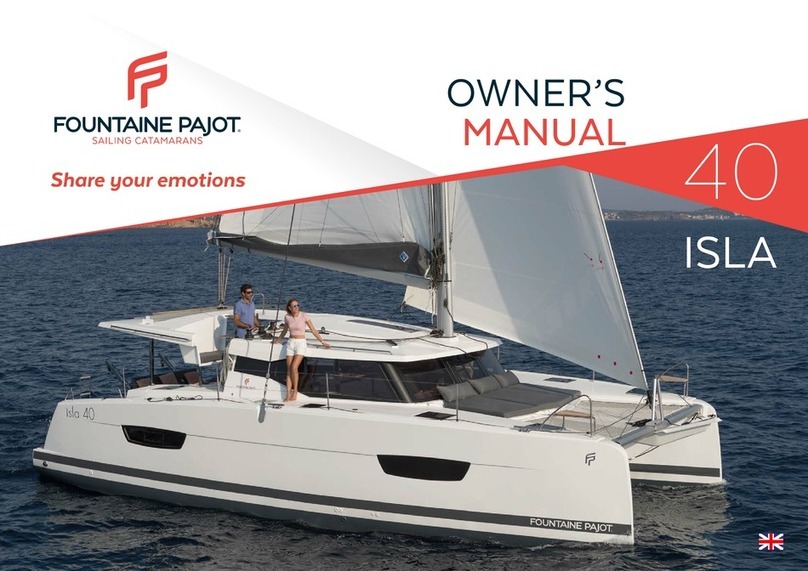
OWNER’S MANUAL / HÉLIA 44 OWNER’S MANUAL / HÉLIA 44 76
Technical Specifications
DESIGN CATEGORIES NAVIGATION TYPE WIND FORCE
(BEAUFORT SCALE) WIND SPEED WAVE HEIGHT TO TAKE INTO
CONSIDERATION
A Ocean-going > 8 ≤ 28 m/s > 4 m
BOff the coast ≤ 8 ≤ 21 m/s ≤ 4 m
CNear the coast ≤ 6 ≤ 17 m/s ≤ 2 m
DProtected water ≤ 4 ≤ 13 m/s ≤ 0,5 m
DESIGN CATEGORY
MANUFACTURER’S PLATE IDENTITY SHEET
CHARACTERISTICS
Your HÉLIA 44 belongs to the « OCEAN-GOING » category (category A).
A
pleasure boat of design category A is considered as designed for winds which can
exceed force 8 (in the Beaufort scale) and for waves which can exceed a height
of 4metres, excluding exceptional conditions such as thunderstorms, violent storms,
tornadoes and extreme maritime conditions or huge waves.
The navigation ability also depends on the crew’s skills. Their physical abilities, the
condition of the boat and hardware.
Be very careful before going to sea. Fountaine Pajot cannot guarantee the perfect ope-
ration of the boat in exceptional sea conditions (violent storms, hurricanes, cyclones,
tornadoes, etc.)
The Hélia 44 is a boat susceptible to capsize and to stay inverted if there are excessive
sails. This is why it is important to respect the sail reduction table.
General
LENGTH (LH) 13,30 m / 43,50 ft
HULL WIDTH (BH) 7,40 m / 24,3 ft
DRAUGHT 1,16 m / 3,8 ft
AIR DRAUGHT 21,65 m / 71 ft
LIGHT DISPLACEMENT 12 837 kg
MAXIMUM LOAD DISPLACEMENT 16 535 kg
The maximum load recommended includes the weight of all members on board, the provisions and per-
sonal belongings, all equipment not included in the weight of the light displacement of the boat, the cargo
and the all consumable liquids (water, fuel, etc.)
1Weight
DESIGNATION WEIGHT
Fuel weight 400 kg – 470 L
Fresh water weight 750 kg – 750 L
Black and grey water weight 180 kg
Liquids total weight 1330 kg
Surface of sails
MAINSAIL GENOA GENAKER (OPTIONAL)
70 m2/ 753,5 ft245 m2/ 484,4 ft286 m2/ 925,7 ft2
Inboard engines
BRAND REFERENCE POWER CRUISING RATE MAX. RATE
Volvo D2-40 2x40 cv / 2x29,4 kW 1800 rpm 3000 rpm
Volvo D2-50 2x50 cv / 2x35 kW 2300 rpm 3000 rpm
Yanmar 4JH45CE 2x45 cv / 2x33,1 kW 2200 rpm 3000 rpm
Yanmar 4JH57C 2x57 cv / 2x40,2 kW 2200 rpm 3200 rpm
Electricity
STARBOARD ENGINE/
SERVICE BATTERY PACK 12 V 4 x 150 Ah + 1 x 150 Ah (optional)
PORT ENGINE BATTERY PACK 12 V 1 x 50 Ah
Dinghy
MAXI DINGHY LENGTH 3,40 m
MAX. LOAD PER DAVIT 100 kg
Life raft
MAX. LIFE RAFT DIMENSIONS 800 x 530 x 320 cm
CIN NUMBER 054
BUILDER
FOUNTAINE PAJOT
Industrial area
17 290 Aigrefeuille d'Aunis
TYPE OF BOAT CATAMARAN
SERIES HÉLIA


































